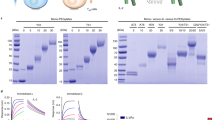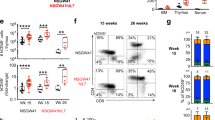Abstract
We have been developing both local and systemic gene therapy approaches to treat inflammatory and autoimmune diseases. To determine if systemic, constitutive expression of biologically active anti-inflammatory agents is therapeutic and/or has associated toxicity, mouse hematopoietic stem cells were infected with retroviral vectors carrying the genes for human IL-1 receptor antagonist (IL-1Ra), human soluble TNF receptor p75 (sTNFR), or the β-galactosidase (lacZ) gene, and transplanted into lethally irradiated recipients. The serum levels of human IL-1Ra and human sTNFR in the long-term reconstituted mice, 2–7 months after transplantation, were 596 and 158 ng/ml respectively. The long-term expression of human IL-1Ra had minimal effects on the PBMC profile whereas human sTNFR expression increased the percentage of B220 and Mac.1 stained cells and decreased slightly the specific T cell subsets. The ability of these proteins to protect the transplanted mice from endotoxin treatment was determined by measuring serum interleukin-6 (IL-6) and interleukin-10 (IL-10) responses after LPS injection at 1.5, 3, 4.5 and 24 h after treatment. The IL-1Ra group showed diminished IL-10 levels and less mortality after injection of LPS compared to the lacZ controls. Mice expressing sTNFR had lower IL-10 and IL-6 levels following injection of LPS. These results demonstrate that constitutive, systemic expression of IL-1Ra and sTNFR is able to confer partial protective effects following treatment with endotoxin. These results further demonstrate that gene transfer methods which result in systemic, long-term expression of immunodulatory proteins could be applied to the treatment of inflammatory diseases.
This is a preview of subscription content, access via your institution
Access options
Similar content being viewed by others
Author information
Authors and Affiliations
Rights and permissions
About this article
Cite this article
Doughty, L., Patrene, K., Evans, C. et al. Constitutive systemic expression of IL-1Ra or soluble TNF receptor by genetically modified hematopoietic cells suppresses LPS induction of IL-6 and IL-10. Gene Ther 4, 252–257 (1997). https://doi.org/10.1038/sj.gt.3300387
Received:
Accepted:
Issue Date:
DOI: https://doi.org/10.1038/sj.gt.3300387
Keywords
This article is cited by
-
The roles of interleukin-1 and interleukin-1 receptor antagonist in antigen-specific immune responses
Journal of Biomedical Science (2002)
-
Thérapie génique de la douleur
Douleur et Analgésie (2001)



